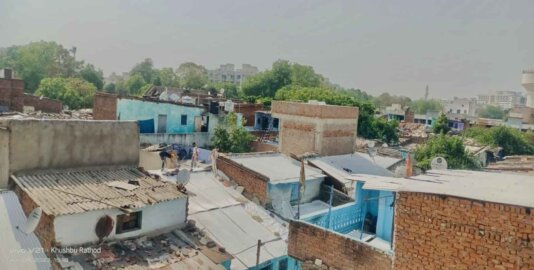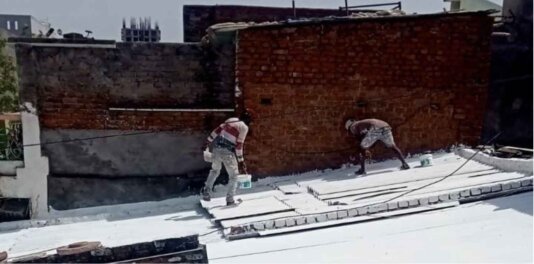- About
- Topics
- Picks
- Audio
- Story
- In-Depth
- Opinion
- News
- Donate
- Signup for our newsletterOur Editors' Best Picks.Send
Read, Debate: Engage.
| July 03, 2023 | |
|---|---|
| topic: | Climate Change |
| tags: | #climate adaptation, #climate change, #environment, #India, #heatwaves |
| located: | India |
| by: | Naila Khan |
Clad in a pink saree, draping a scarf over her face and covering her feet with socks, 46-year-old Godavari Dange has returned home from a rigorous awareness session. For over two decades, Dange has been educating women farmers on developing sustainable climate solutions while working at Swayam Shikshan Prayog, a non-profit based in Pune in the western Indian state of Maharashtra.
Every March, Dange, along with her team members, visits the Marathwada region of Maharashtra - known for its frequent droughts - in order to organise awareness sessions. There, they train women farmers to grow climate resilient seasonal crops, and inform them of local solutions to beat the heat while working the land.
“Women farmers are hit hardest by rising temperatures, so we train them to develop an alternative farming model,” Dange told FairPlanet. “We encourage them to grow seasonal food crops instead of water-intensive cash crops. We simultaneously inform them to stay cool during a heatwave, advising them with simple solutions to avoid daytime work and suggesting visits to the farms during the early morning or sunset hours.”
India has been alarmed by the increasingly early onset of summer. This year, for instance, witnessed the hottest February since 1901 according to the India Meteorological Department (IMD).
Tragically, in April, 13 people lost their lives due to heatstroke after attending a government-sponsored event in Maharashtra, where they were exposed to the open sun for hours.
Generally, the IMD declares a heatwave when the maximum temperature is above 40 degrees Celsius for two consecutive days in the plains, above 37 degrees celsius in coastal areas and above 30 degrees celsius in the hills and mountains.
Recognising the need for immediate action, organisations like Mahila Housing Trust (MHT) are implementing innovative solutions to combat extreme heat in low-income communities.
Summer in Ahmedabad, Gujarat has always been a dreadful time for Bharti Ben, a 35-year-old resident of a slum. “Her home temperatures can rise as high as 45 degrees Celsius (113 degrees Fahrenheit).” The intense heat made her two-room house unbearable, forcing her to avoid staying indoors.
Researchers highlight that the impact of extreme heat is particularly severe in slums, which can experience temperatures up to 6 degrees Celsius higher than other city neighbourhoods.
Last year, the heat in her home got so intense that Ben fainted while performing household chores. The trauma from this experience made Ben even more eager to spend as much time as possible outdoors.
This year, with the help of MHT, Ben got her roof painted with white reflective paint. As part of its work, the non-profit encourages women to adopt solutions like white paint to reflect sunlight off their rooftops, which leads to reduced temperatures inside homes.
After the paint job was completed, Ben was able to spend her afternoon inside and even work. “It used to be so hot inside, now the temperatures have gone down by 5 to 7 degrees Celsius,” she told FairPlanet.
Covering one roof with a coat of sun reflective white paint costs approximately 33 euros (3000 Indian Rs) - an affordable alternative for slum residents with limited financial resources who cannot access conventional cooling options like air conditioners.
The non-profit has also expanded its scope beyond facilitating the installation of cooling roofs or cheaper alternatives like sun-reflective white paint to include early warning systems for heat and floods, water quality testing, and cleanliness drives, among other initiatives, all spearheaded by women.
MHT organises women from both informal and formal slum settlements into Community Action Groups (CAG) to run its programmes.
Heat Actions Plans (HAP) are documents that combine assessments and actions across agencies to respond to and reduce heat-related risks. These plans are intended to serve as India's primary policy approach to manage and adapt to heat waves.
They build resilience to extreme heat events through public awareness, community outreach, inter-agency coordination to enable an early warning system, capacity building among healthcare professionals and promoting adaptive measures to reduce heat exposure.
India’s first heat action plan was launched in Gujarat in 2013, and has since expanded to over 23 states and more than 100 cities and districts through the National Disaster Management Authority (NDMA), India’s apex body for disaster management.
However, according to the Centre for Policy Research (CPR), a New Delhi based think-tank that conducted a critical assessment of HAPs, most of these plans may not be appropriate for the risks faced by local populations as they are not tailored to local contexts.
In an interview for The Hindu, Aditya Pillai, a research associate and co-author of the report, said: “India has made considerable progress by creating several dozen heat action plans in the last decade. But our assessment reveals several gaps that must be filled in future plans.
“If we don’t, India will suffer damaging economic losses due to decreasing labour productivity, sudden and frequent disruptions to agriculture (like we saw last year), and unbearably hot cities as heatwaves become more frequent and intense.”
Dileep Mavalankar, director of the Indian Institute of Public Health in Gujarat who helped develop South Asia’s first heat action plan in 2013 in Ahmedabad, holds similar views. “The current heat action plans in India are very ‘general’ and most of them lack proper implementation,” he told FairPlanet.
Mavalankar further stated that heat-related deaths go largely unnoticed in India. “We don't compile our mortality data accurately. States need to compare mortality numbers to previous years to ascertain heat-related deaths, a data set that is underdeveloped in the country.”
Meanwhile, a report published by NDMA pointed out that heat-wave victims disproportionately come from poverty-stricken, vulnerable and unorganised backgrounds. This includes daily-wage labourers, street vendors, brickmaking workers, construction workers, rickshaw pullers, delivery executives and gig workers who are obligated to work outdoors in order to sustain their livelihood.
Women's networks such as Swayam Shikshan Prayog and Mahila Housing Trust offer opportunities for disseminating heat-related information, promoting awareness and building resilience at the local level.
According to experts such as Mavalankar, initiatives such as heat action plans and community outreach programmes aimed at reducing exposure to extreme heat have proven to be effective in enhancing heat resilience.
“Heatwaves are only going to get worse due to climate change, but public awareness and promoting adaptive measures are immediately needed for India to navigate a hotter world,” he concluded.
Cover photo by Tom Chen
By copying the embed code below, you agree to adhere to our republishing guidelines.


